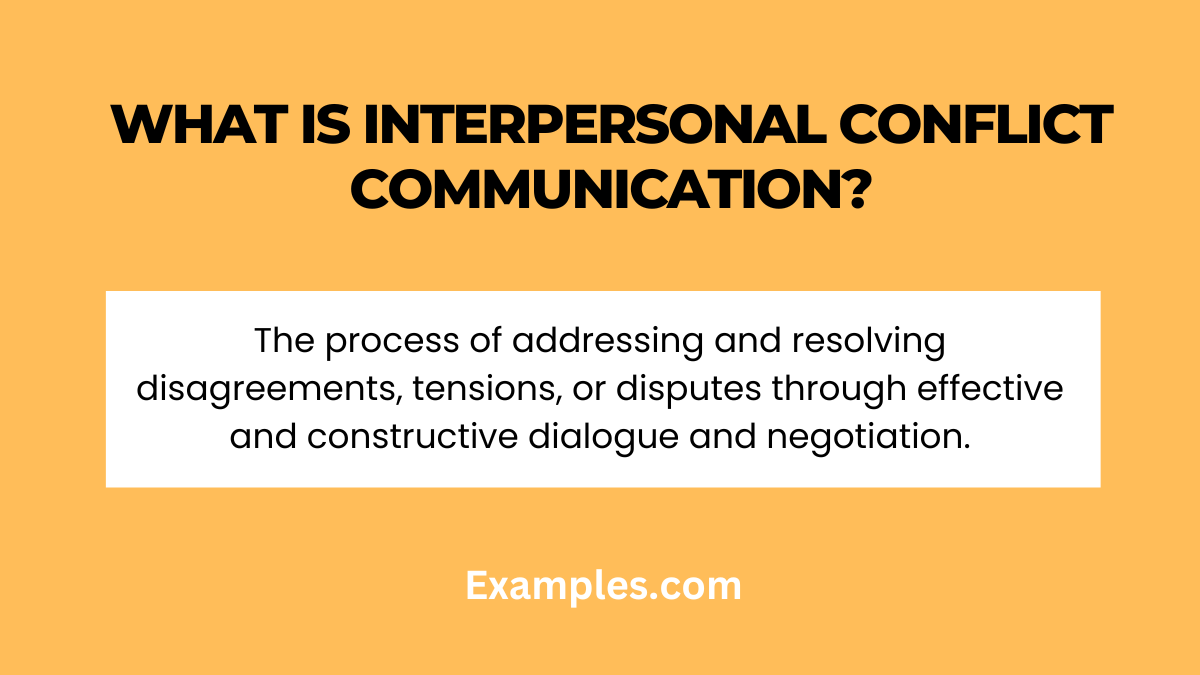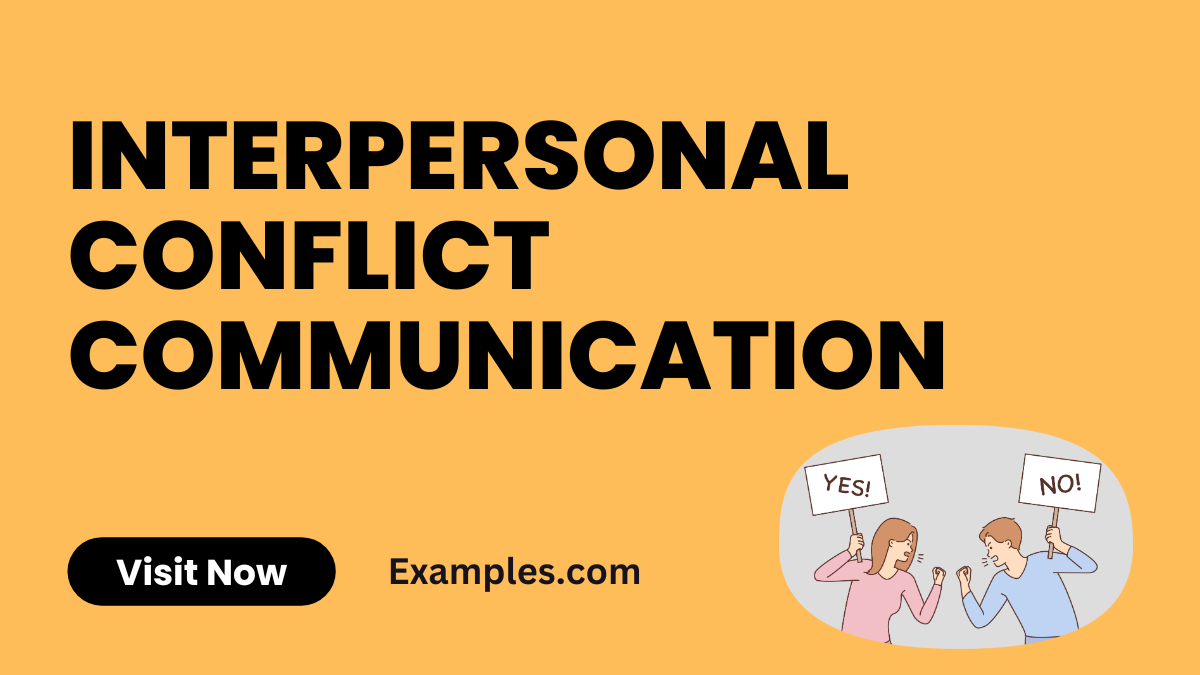19+ Interpersonal Conflict Communication Examples
Interpersonal Conflict Communication plays a pivotal role in shaping our interactions and relationships. This guide delves into the nuances of communicating effectively during conflicts, providing practical examples and tips. We explore various types of interpersonal communication, such as verbal, non-verbal, and digital, and how they influence conflict resolution. Understanding these dynamics can significantly improve both personal and professional relationships, making this guide an essential read for anyone looking to enhance their communication skills.
What is Interpersonal Conflict Communication?

Interpersonal Conflict Communication refers to the process of exchanging information and feelings between individuals during conflicts. It involves various forms of interpersonal communication, including verbal, non-verbal, and emotional expression. Effective conflict communication aims to resolve disagreements while maintaining respect and understanding between parties. It’s a crucial skill for managing personal relationships and professional interactions.
What is the Best Example of Interpersonal Conflict Communication?

One of the best examples of Interpersonal Conflict Communication is a workplace disagreement where both parties use assertive yet respectful language. In this scenario, individuals express their viewpoints and listen actively, employing both verbal communication and non-verbal cues like body language to convey understanding. This approach helps in reaching a mutually agreeable solution, demonstrating effective conflict communication. This kind of interaction not only resolves the immediate issue but also strengthens the relationship by fostering trust and respect.
20 Examples of Interpersonal Conflict Communication

Interpersonal conflict communication is a critical skill in navigating disagreements and fostering healthy relationships. This article explores 20 unique and insightful examples, each with a two-line explanation and example sentences, demonstrating effective strategies in verbal communication in interpersonal communication and listening in interpersonal communication. These examples offer practical guidance for resolving conflicts, enhancing understanding, and maintaining positive interactions in various settings.
- Disagreeing Politely in a Work Meeting: When a colleague proposes a strategy you disagree with, respond with, “I see your point, but have you considered this alternative?” This approach shows respect while presenting your perspective.
- Active Listening During a Family Dispute: In a heated family discussion, saying, “I understand you’re upset, and I want to hear more about your feelings,” demonstrates active listening and empathy.
- Assertive Communication in a Partnership: In a relationship, instead of accusing, say, “I feel concerned when you do this. Can we talk about it?” This expresses your feelings without blaming the other person.
- Giving Constructive Feedback to a Friend: When offering feedback, phrase it positively: “I appreciate your effort, and maybe trying this way could enhance the outcome.” It combines encouragement with guidance.
- Resolving Misunderstandings with Colleagues: If a misunderstanding arises, clarify by asking, “Can you help me understand your perspective on this issue?” This invites open dialogue and clarification.
- Negotiating Compromises in Small Groups: In group settings, suggest, “Let’s find a middle ground that works for everyone.” It promotes collaboration and compromise.
- De-escalating Tensions in Public Situations: In public conflicts, intervene with, “Let’s take a moment to calm down and discuss this rationally.” This helps lower emotional intensity.
- Digital Communication to Resolve Conflicts: When texting, use clear language and avoid sarcasm: “I want to understand your point. Can we discuss this in detail?” This prevents misinterpretation.
- Non-Verbal Cues in Emotional Conversations: During emotional talks, maintain open body language and nod to show you’re listening and empathetic.
- Seeking Clarification in Written Communication: In emails, ask for specifics: “Could you clarify this point for me?” This ensures you understand the message correctly.
- Respecting Boundaries in Emotional Expression: When someone is upset, respect their space but offer support: “I’m here if you need to talk.” It shows care without intrusion.
- Encouraging Openness in Visual Communication: Use visual aids to explain complex issues, making it easier for others to grasp and discuss your viewpoint.
- Bridging Gaps in Cultural Communication: Acknowledge cultural differences by saying, “I respect your perspective. Can you tell me more about it?” This fosters mutual understanding.
- Feedback in Team Projects: In team projects, encourage input: “Everyone’s ideas are valuable. Let’s hear different perspectives.”
- Handling Criticism in Professional Settings: When criticized, respond with, “I appreciate your feedback. How can I improve?” It shows willingness to learn and grow.
- Articulating Needs in Personal Relationships: Express needs clearly: “I need some time alone right now. Let’s talk later.” It conveys your needs respectfully.
- Empathetic Responses in Healthcare: Healthcare professionals can say, “I understand this is tough. How can I support you?” showing empathy and care.
- Inclusive Discussions in Educational Settings: Teachers can foster inclusivity by asking, “What are everyone’s thoughts on this topic?” It encourages diverse viewpoints.
- Positive Reinforcement in Parent-Child Communication: Reinforce good behavior with, “I’m proud of how you handled that situation,” to encourage positive actions.
- Resolving Customer Complaints: In customer service, acknowledge the issue: “I see why that’s frustrating. Let’s find a solution together.” This validates their concerns and seeks resolution.
Interpersonal Conflict Communication in the Workplace

Effective Interpersonal Conflict Communication in the workplace is pivotal for maintaining a harmonious and productive environment. Incorporating strategies like active listening, clear verbal exchanges, and constructive feedback helps mitigate conflicts. Understanding and implementing various types of interpersonal communication can foster a positive atmosphere, enhancing team dynamics and problem-solving abilities.
- “Let’s discuss this issue and find a solution together.”
- Encourages collaborative problem-solving, showing willingness to understand and resolve workplace disagreements.
- “I understand your perspective, but here’s my viewpoint.”
- Demonstrates respect for others’ opinions while confidently expressing one’s own, essential for healthy workplace dialogue.
- “Can we schedule a meeting to talk about this misunderstanding?”
- Suggests a structured approach to resolving conflicts, highlighting the importance of dedicated time for communication.
- “I appreciate your hard work, but there’s room for improvement.”
- Combines positive reinforcement with constructive criticism, vital for growth and learning in a professional setting.
- “I feel we’re not on the same page. Let’s clarify our goals.”
- Aims to align team objectives, emphasizing the need for clarity in collaborative projects.
- “Your feedback is valuable to me. Let’s explore your ideas.”
- Acknowledges the importance of diverse viewpoints, fostering an inclusive and innovative work environment.
- “I apologize for any confusion caused. Let’s rectify this together.”
- Takes responsibility and promotes a cooperative approach to problem-solving.
- “Let’s take a break and revisit this with fresh perspectives.”
- Recognizes the importance of taking a step back to prevent escalation and maintain a healthy work environment.
- “I believe there’s a misunderstanding. Here’s what I meant.”
- Clarifies potential miscommunications, crucial for maintaining clear and effective workplace interactions.
- “Your concerns are valid. Let’s address them point by point.”
- Shows respect for colleagues’ concerns and willingness to engage in detailed, constructive discussions.
Interpersonal Conflict Communication in Relationship

Interpersonal Conflict Communication in relationships revolves around effectively managing differences and misunderstandings. Utilizing tools like empathetic listening, honest verbal communication, and open expression of feelings ensures healthy and resilient bonds. Recognizing and respecting each other’s emotional needs is fundamental in nurturing long-lasting, loving relationships.
- “I feel hurt when you say that. Can we talk about it?”
- Expresses personal emotions honestly, paving the way for open and caring discussions in intimate relationships.
- “I understand your point, but let’s find a common ground.”
- Promotes compromise and mutual understanding, key in resolving conflicts in relationships.
- “Let’s take a moment to cool down before we continue this conversation.”
- Suggests a pause to prevent heated arguments, showing the importance of managing emotions constructively.
- “Your happiness matters to me. Let’s work this out together.”
- Emphasizes the value of the partner’s well-being, reinforcing commitment and care in the relationship.
- “I apologize for my part in this misunderstanding.”
- Shows accountability and the willingness to mend issues, vital for trust and respect in relationships.
- “Can you help me understand why you feel this way?”
- Seeks to comprehend the partner’s perspective, essential for empathy and deeper connection.
- “I appreciate your honesty. Let’s use this to grow stronger.”
- Values open communication, recognizing it as a foundation for relationship growth and strength.
- “Let’s not jump to conclusions. Can you explain more?”
- Encourages thorough discussion instead of assumptions, crucial for clarity and understanding.
- “This is important to you, so it’s important to me.”
- Acknowledges the significance of the partner’s concerns, fostering a supportive and nurturing environment.
- “I love you, and we’ll get through this together.”
- Reinforces love and solidarity, essential for overcoming challenges and building a resilient bond.
How to Handle Interpersonal Conflict in Communication?
Interpersonal conflict in communication can be a challenging aspect to navigate. However, with the right strategies, it’s possible to handle these conflicts effectively, fostering a more productive and positive interaction. Here are some key points to consider:
1. Understand the Nature of the Conflict
- Begin by identifying the root cause of the conflict. Is it a misunderstanding, a clash of values, or perhaps related to Verbal Communication in Interpersonal Communication? Understanding the nature of the conflict is the first step towards resolution.
2. Practice Active Listening
- Active listening involves paying full attention to the other person, understanding their perspective, and reflecting back what you have heard. This is a critical element of Listening in Interpersonal Communication. By doing so, you show respect for their viewpoint and create a space for open dialogue.
3. Use “I” Statements
- Instead of placing blame, express how you feel and what your concerns are. “I” statements help in reducing defensiveness and focus on your feelings rather than accusing the other person.
4. Manage Emotions
- Keep your emotions in check. High emotions can escalate the conflict. Practice emotional regulation techniques like deep breathing or taking a short break before continuing the conversation.
5. Seek Common Ground
- Focus on finding commonalities rather than differences. This approach can help in de-escalating the conflict and finding a mutually agreeable solution.
6. Respect Differences
- Acknowledge and respect that different people have different perspectives. This understanding is crucial in Interpersonal Communication Examples where diverse viewpoints come into play.
7. Avoid Blame and Criticism
- Blame and criticism can worsen the conflict. Instead, focus on the issue at hand and discuss it constructively.
8. Work Towards a Solution
- Aim for a solution that is acceptable to all parties involved. It might involve compromise or a new, creative approach to the problem.
9. Follow Up
- After reaching a resolution, check back to ensure that the solution is working and that no new issues have arisen.
10. Seek External Help if Needed
- If the conflict seems unresolvable, consider seeking help from a mediator or a professional skilled in conflict resolution.
Handling interpersonal conflict effectively is crucial for maintaining healthy relationships in both personal and professional settings. Incorporating these strategies can lead to more constructive and satisfying interactions.
In conclusion, mastering interpersonal conflict communication is essential for healthy and constructive interactions in both personal and professional spheres. Embracing strategies like active listening, empathetic responses, and clear expression can transform conflicts into opportunities for growth and understanding. To delve deeper into these skills, resources such as Harvard University’s Conflict Resolution offer valuable insights. Additionally, the American Psychological Association provides research-based strategies for conflict resolution, enhancing your communication toolkit for various interpersonal scenarios.



